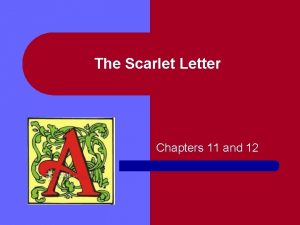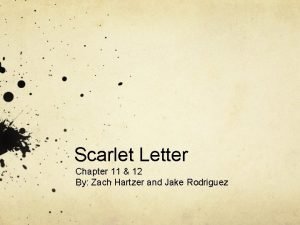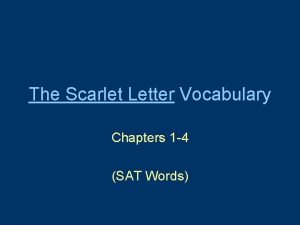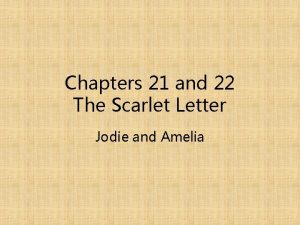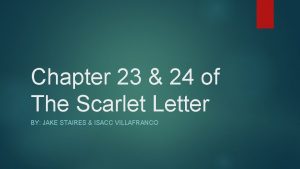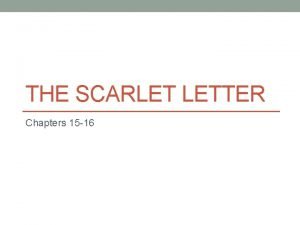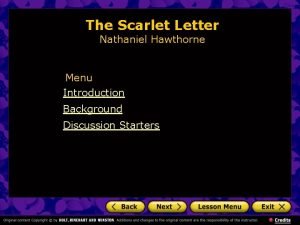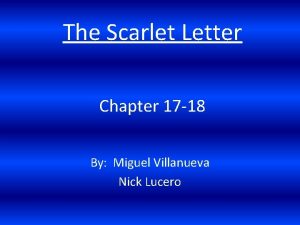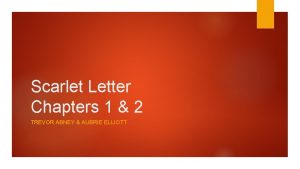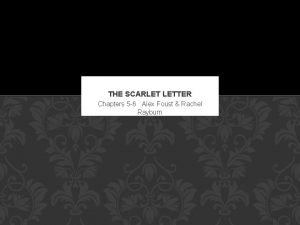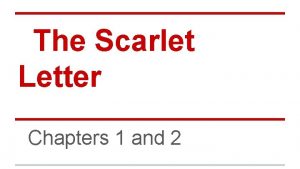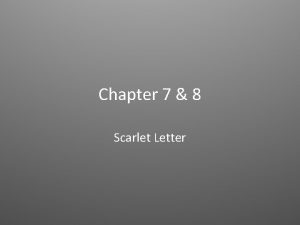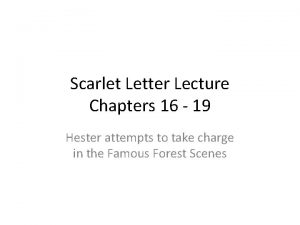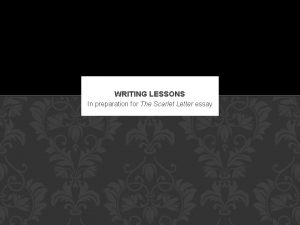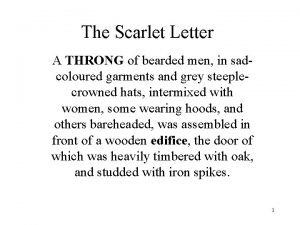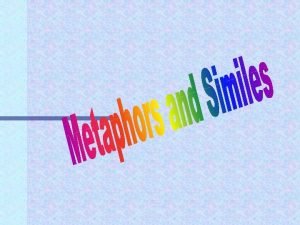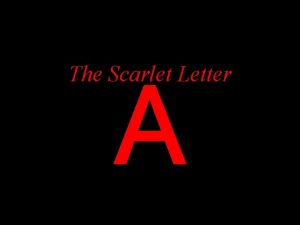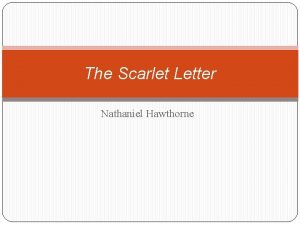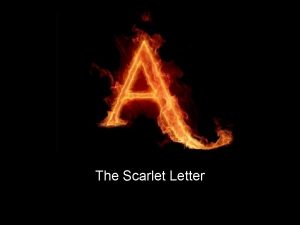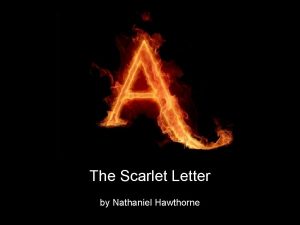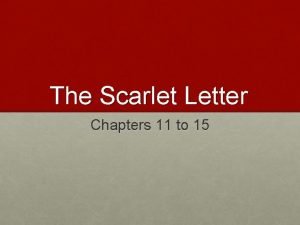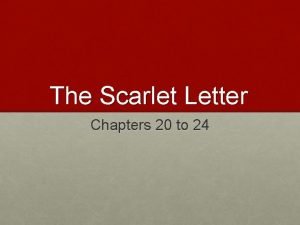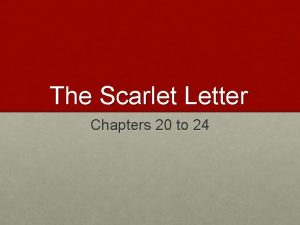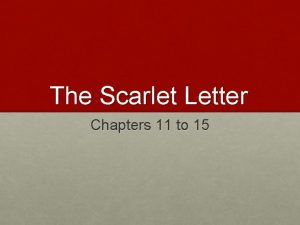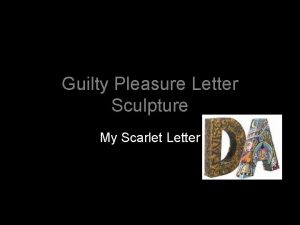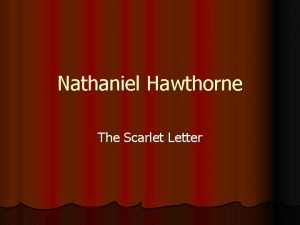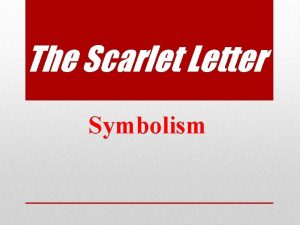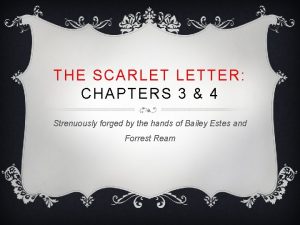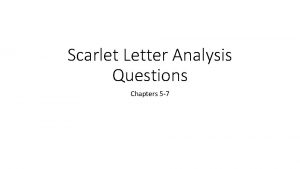The Scarlet Letter Chapters 7 to 10 Warm
















- Slides: 16

The Scarlet Letter Chapters 7 to 10

Warm UP: Cite specific quotes or passages when answering the following questions: • What did you find most compelling in these chapters? • What did you find most frustrating (beyond Hawthorne’s verbosity)? • What did you find most confusing? How could that confusion be resolved? (Did a group mate explain? Did you experience an aha moment during discussion? Are you still confused? )

1. “The Governor's Hall”… • Basic: Describe Governor Bellingham’s estate. • Higher Level: Explore the irony of the description of Bellingham’s estate. • Highest Level: Explain how the irony of Bellingham’s estate reinforces Hawthorne’s assertion regarding Puritan morality.

What Do We Learn about Pearl, Her Conception and Her Parents? There was fire in her and throughout her; she seemed the unpremeditated offshoot of a passionate moment. Her mother, in contriving the child's garb, had allowed the gorgeous tendencies of her imagination their full play; arraying her in a crimson velvet tunic, of a peculiar cut, abundantly embroidered with fantasies and flourishes of gold thread. So much strength of coloring, which must have given a wan and pallid aspect to cheeks of a fainter bloom, was admirably adapted to Pearl's beauty, and made her the very brightest little jet of flame that ever danced upon the earth (Hawthorne 102).

“Pearl, seeing the rosebushes, began to cry for a red rose, and would not be pacified” (Hawthorne 107). Consider the rose bush’s symbolism explicated in chapter one and the symbolism developed surrounding Pearl in the chapters that follow. How does Pearl’s obsession over a rose that from Bellingham’s struggling garden.

2. “The Elf-Child and the Minister” Cite examples of light and dark imagery and explore this motif’s possible purposes. Who is shrouded in shadow or darkness? Who is illuminated? What are these characters other qualities? What message is Hawthorne beginning to reveal?

2. “The Elf-Child and the Minister” • Basic: What is Hester’s argument for maintaining custody of Pearl? • Higher Level: How does her argument further develop Hawthorne’s use of juxtaposition? • Highest Level: What is ironic about Hester’s argument and its outcome? What purpose does that irony serve?

3. “The Elf-Child and the Minister” • Basic: Summarize the characterization of Mistress Hibbins and her conversation with Hester at the conclusion of chapter 8. • Higher Level: How does this conversation and characterization further the novel’s plot as well as its irony?

4. “The Leech” • Why does the man now known “under the appellation of Roger Chillingworth” resolve that his former name “should never more be spoken” (117)? • What is the symbolic purpose of this change and his new chosen name? • What is Hawthorne suggesting about Chillingworth and humans in general when explaining his period of captivity with Native Americans and the knowledge gained during that time (first 4 pages of chapter 9)?

“the Leech” • Explore the significance of the following quote in the novel’s context and in our daily lives. • “When an uninstructed multitude attempts to see with its eyes, it exceedingly apt to be deceived” (Hawthorne 125). • What might “see” and “eyes” mean beyond their literal meaning? • Who is being deceived (in the novel and the world)? • Why are they being deceived?

5. “The Leech and His Patient” • Explore the diction used in the opening three paragraphs of “The Leech and His Patient. ” To what two things is Hawthorne comparing Chillingworth and Dimmesdale’s relationship? What is the significance of each comparison?

6. “The Leech and His Patient” What is Chillingworth attempting to find through his “digging”? What is ironic about the imagery used to represent this discovery? • To sum up the matter, it grew to be a widely diffused opinion, that the Reverend Arthur Dimmesdale, like many other personages of especial sanctity, in all ages of the Christian world, was haunted either by Satan himself, or Satan's emissary, in the guise of old Roger Chillingworth. This diabolical agent had the Divine permission, for a season, to burrow into the clergyman's intimacy, and plot against his soul (Hawthorne 126). • He now dug into the poor clergyman's heart, like a miner searching for gold; or, rather, like a sexton delving into a grave, possibly in quest of a jewel that had been buried on the dead man's bosom, but likely to find nothing save mortality and corruption. Alas for his own soul, if these were what he sought! • Sometimes, a light glimmered out of the physician's eyes, burning blue and ominous, like the reflection of a furnace, or, let us say, like one of those gleams of ghastly fire that darted from Bunyan's awful door-way in the hill-side, and quivered on the pilgrim's face. The soil where this dark miner was working had perchance shown indications that encouraged him. (Hawthorne 127)

How is that imagery continued here? Tie it into other symbols or motifs that we have seen thus far. “[W]here, my kind doctor, did you gather those herbs, with such a dark, flabby leaf? " “Even in the grave-yard, here at hand, " answered the physician, continuing his employment. "They are new to me. I found them growing on a grave, which bore no tombstone, no other memorial of the dead man, save these ugly weeds that have taken upon themselves to keep him in remembrance. They grew out of his heart, and typify, it may be, some hideous secret that was buried with him, and which he had done better to confess during his lifetime. ” (Hawthorne 129)

With whom do you agree? Why? "But, not to suggest more obvious reasons, it may be that they are kept silent by the very constitution of their nature. Or, --can we not suppose it? -guilty as they may be, retaining, nevertheless, a zeal for God's glory and man's welfare, they shrink from displaying themselves black and filthy in the view of men; because, thenceforward, no good can be achieved by them; no evil of the past be redeemed by better service. So, to their own unutterable torment, they go about among their fellow-creatures, looking pure as new-fallen snow; while their hearts are all speckled and spotted with iniquity of which they cannot rid themselves. " Wouldst thou have me to believe, O wise and pious friend, that a false show can be better--can be more for God's glory, or man's welfare--than God's own truth? Trust me, such men deceive themselves!“ (Hawthorne 130)

7. “The Leech and His Patient” • What Romantic/Transcendental elements are used to further the novel’s symbolism and plot? Beyond their representation of Romantic elements, what function do they serve?

“The Elf-Child and the Minister” • Starting with chapter 8, explore how the characterization of each key player’s physical being is used to reflect his or her psychological development.
 Sparknotes scarlet letter chapter 11
Sparknotes scarlet letter chapter 11 Irony in chapter 11 of the scarlet letter
Irony in chapter 11 of the scarlet letter The scarlet letter vocabulary chapters 1-4
The scarlet letter vocabulary chapters 1-4 Chapter 21 scarlet letter summary
Chapter 21 scarlet letter summary The scarlet letter chapter 23 summary
The scarlet letter chapter 23 summary The scarlet letter chapter 6 summary
The scarlet letter chapter 6 summary Sky and grass letters
Sky and grass letters Scarlet letter background
Scarlet letter background Scarlet letter 17-18
Scarlet letter 17-18 Aubrie scarlet
Aubrie scarlet The scarlet letter chapter 5 summary
The scarlet letter chapter 5 summary Scarlet letter chapter 1-2 summary
Scarlet letter chapter 1-2 summary Scarlet letter chapter 7 summary
Scarlet letter chapter 7 summary The scarlet letter chapter 16
The scarlet letter chapter 16 Is the scarlet letter italicized
Is the scarlet letter italicized A throng of bearded
A throng of bearded Pen metaphors
Pen metaphors
